1860s

Karl Gutzlaff dressed as a Chinese sailor.
Although the first Evangelical missionaries to settle in Shandong are usually recognized as C.J. Hall and Hendrick Kloeckers of the English Baptist Mission in 1860, the German pioneer Carl Gutzlaff visited coastal areas of the province in 1832 and 1833, distributing gospel literature as he went. Gutzlaff wore Chinese clothing and dispensed medicine and gospel tracts wherever he traveled. When his ship docked in the Bay of Weihai in July 1832, Gutzlaff disembarked and roamed over the nearby hills among several fishing villages, only to find "an unfriendliness, which seemed depicted on every countenance." 1
Two years later in August 1835, Edwin Stevens from Connecticut and Englishman Walter Medhurst followed in Gutzlaff's steps by sailing along the coast of Shandong. They took on board with them 20,000 Chinese Bibles, books and booklets of various kinds, which they intended to distribute to people along their route. At Weihai they received a hostile welcome, however, as this was the era of the Opium Wars in China, when foreigners were generally despised. Two days later, however, they found one village where "the people were too eager to wait for the regular distribution and disposed to help themselves. Within two days they were able to distribute about 1,000 volumes of 100 pages each." 2
James Holmes and his wife Sallie of the American Southern Baptist Mission settled in Chefoo (now Yantai) in 1860, followed the next year by Jesse and Eliza Hartwell in Tengzhou (now Penglai). Holmes' life was tragically cut short just one year after arriving in the province.
The cause of Christian work in Shandong was boosted by an appeal from Welshman Griffith John—one of the greatest of the early Evangelical missionaries to China. John traveled north from his base in Hubei Province and arrived in the coastal city of Yantai in December 1860. His stirring words were widely reported among the churches in America and Britain:
"Whilst our hearts overflow with joy at the extensive field so suddenly and marvelously opened up, we are ready to despond at the inadequacy of the means. What is one station and two missionaries for the whole of Shandong Province, with its 29 million human souls?... Nothing, absolutely nothing!
"Will the Church, unfaithful to her Head, and false to herself, as the depository of the blessings of light and life for the world, look on with indifference?" 3
Griffith John was not merely a skilled orator. He flung himself into the work, personally visiting most of the towns and villages surrounding Yantai. John was attracted to the people of Shandong, whom he described as
"more friendly than those of the south. Idolatry has not so strong a hold upon them, and many seem to be more susceptible of religious impressions, having a distinct notion of a Supreme Spiritual Being. Their disposition to clannishness, which is a marked social feature, will also be helpful to progress the gospel. Many villages, with from 500 to 5,000 people, are composed entirely of one or two families, and to influence one person means to influence all; whilst the conversion of one of the principal men would be followed by the respectful attention of the whole clan to the truth." 4
A trickle of Western Evangelical missionaries from various denominations settled in Shandong throughout the 1860s, only to discover their Catholic counterparts had beaten them to the province by hundreds of years. By 1663 the Catholic Church already counted 3,000 converts in Shandong. 5 This number grew to 10,750 by 1870. 6
By comparison, Evangelicals struggled to gain a foothold in Shandong. In other parts of China, the early missionaries had used public meetings and literature distribution to great effect. The pioneers in Shandong, however, soon discovered the province was different and had to adjust their strategies accordingly. An historian wrote,
"The gentry and the populace opposed the teachings of the new religion. Open-air services and the distribution of tracts, methods used in young mission fields throughout the world, brought little response here. Thus, in order to gain a basic hearing for the gospel, many missionaries turned to the running of primary schools and small hospitals and clinics, much to the dismay of the home boards, who charged that donations for evangelism were being misused." 7
James Holmes and Henry Parker
One of the earliest Evangelical missionaries in Shandong was the American James Holmes, who was born in West Virginia in 1836. Holmes was ordained to the ministry at the age of 22, just a month after his marriage to Sally. The newlyweds had already been appointed as Southern Baptist missionaries. After an arduous ocean journey of six months, they reached China in February 1859.
James and Sallie felt that God wanted them to move to Shandong, but permission was not granted for some time. China was at war with England and France, and only when the war ended and Yantai was made a ‘treaty port’ were the Holmeses allowed to reside in the province. On the last day of 1860 they arrived in Yantai, along with their infant son and the Hartwell family.
In April 1861 Henry Parker and his wife began the work of the American Episcopal Church in Yantai. The Taiping Rebellion was still raging throughout China and conditions were unsafe as groups of bandits took advantage of the unrest to murder and loot. In October 1861, a band of marauders known as the Nianfei approached Yantai. This group had systematically destroyed towns and villages throughout the province, so Holmes and Parker went out to the rebel camp to intercede for the safety of their town. The two missionaries did not return, and "eight days later their bodies were found 15 miles [24 km] from Yantai. Holmes was only 25-years-old when he was killed. Later the people erected a monument in his memory.” 8
Norman Cliff, a former missionary in Shandong and a church historian, wrote, “What exactly took place is not known, but their bodies were recovered, covered with wounds and burns. They were buried on Lighthouse Island in Yantai Bay, as foreigners could not be buried on the mainland.” 9
After Henry Parker’s death, his grieving wife and son returned to the United States, but Sallie Holmes decided to continue the work God had called her to. She relocated to nearby Penglai and continued to serve in Shandong for 20 more years. Later, when the famous Southern Baptist missionary Lottie Moon arrived in the province, the two women became close friends and Moon was much influenced by Holmes’ zeal and enthusiasm.
The first organized Evangelical church in Shandong was established at Penglai in November 1862. The fellowship was founded with eight members. One of the first men baptized was Liu Qingsan, who became a key Evangelical leader in Shandong for the next five decades. In 1880 Liu moved to the provincial capital Jinan, where he established the first Presbyterian congregation. Liu lived to see his children, grandchildren and great grandchildren all following Jesus Christ.

Liu Qingsan at 84-years-old, surrounded by his family of four generations of Christians.
The Trials of the American Presbyterians
Of all the early Evangelical mission agencies in Shandong, none suffered as many setbacks as the American Presbyterians. Two couples, the Gayleys and the Danforths, relocated north from Shanghai to Penglai in May 1861. Both couples had suffered healthy problems from the heat and humidity of Shanghai, and it was thought the 500-mile move to the more agreeable climate of Shandong would help.
Their arrival in Penglai coincided with an outbreak of violence as the province was ravaged by bandits. Less than five months after arriving, Mrs. Danforth died from an undetermined cause. The sudden loss of his partner caused "Mr. Danforth's health to be shattered in body and mind and a man was employed to take him home on the long voyage." 10
In July of the following year (1862) Charles Mills and his wife sailed into Yantai as the latest recruits to help establish Presbyterian work in the province. They arrived during 'the cholera year,' when every day more than 1,000 people died from the dreadful disease. Three of the Mills children perished.
Missionary Samuel Gayley had traveled to Shanghai to accompany the Mills family. On the ship Gayley was stricken and he too passed away soon after reaching home. That year approximately one-third of the population around Yantai died because of the cholera epidemic.
In 1864 two new couples, the Mateers and the Corbetts, left New York and endured the 165-day voyage to China. The steamer scheduled to take them the last stage of their journey to Shandong ran aground off the coast. Fearing the ship would break up and sink during the night,
"Passengers and crew were brought ashore. They wandered for five hours in the snow and ice, and at the point of exhaustion found lodging in a peasant farmhouse.... When it was light, they saw in the distance their ship still afloat on the reef. The men returned to the ship and were able to remove most of their belongings.... Although they nearly did not make it, these two shipwrecked couples would give to China 155 combined years of service!" 11
An Encouraging Breakthrough
Modest growth had occurred among the Evangelical churches in Shandong until 1866, when "there was a remarkable religious awakening" at Leling in the northwest of the province, after missionaries based at Tianjin ventured south to preach the gospel across the border. When W.N. Hall traveled to the area to examine the work, he declared the move of grace to be genuine. Hall and his colleagues
"baptized 45 persons who had eagerly embraced the gospel. From this auspicious beginning there was steady growth and expansion of Christian influence, so that by December 1877, there were in that region, 18 preaching stations, 636 church members, eight schools and 14 native preachers.... The people truly loved and revered the Lord, and always hailed His presence among them with joy." 12
This breakthrough at Leling encouraged the other missionaries throughout Shandong at the time, many of whom had not seen much progress in their labors. The decade of the 1860s concluded with hope that the Holy Spirit would soon water the seeds that had been scattered throughout the province and bring forth a strong and evangelizing church.
© This article is an extract from Paul Hattaway's book 'Shandong: The Revival Province'. You can order this or any of The China Chronicles books and e-books from our online bookstore.
1. John J. Heeren, On the Shantung Front: A History of the Shantung Mission of the Presbyterian Church (New York, NY: The Board of Foreign Missions of the Presbyterian Church in the United States of America, 1940), p. 36.
2. Heeren, On the Shantung Front, p. 39.
3. William Robson, Griffith John: Founder of the Hankow Mission, Central China (New York, NY: Fleming Revell, 1890), p. 48.
4. Robson, Griffith John, p. 49.
5. Nicolas Standaert, Handbook of Christianity in China, Volume One: 635-1800 (Leiden: Brill), 2001, p. 385.
6. Chinese Recorder and Missionary Journal (May 1880), p. 194.
7. Cliff, "Building the Protestant Church in Shandong," p. 63.
8. Winston Crawley, Partners Across the Pacific: China and Southern Baptists, Into the Second Century (Nashville, TN: Broadman Press, 1986), p. 49.
9. Norman Howard Cliff, A History of the Protestant Movement in Shandong Province, China, 1859-1951 (Michigan: A Bell & Howell Company, 1994) p. 39.
10. G. Thompson Brown, Earthen Vessels and Transcendent Power: American Presbyterians in China, 1837-1952 (Maryknoll, NY: Orbis Books, 1997), p. 54.
11. Brown, Earthen Vessels and Transcendent Power, p. 55.
12. Rev J. Innocent, "In Memoriam, Rev. W. Nelthorpe Hall," Chinese Recorder and Missionary Journal (December 1878), p. 463.





